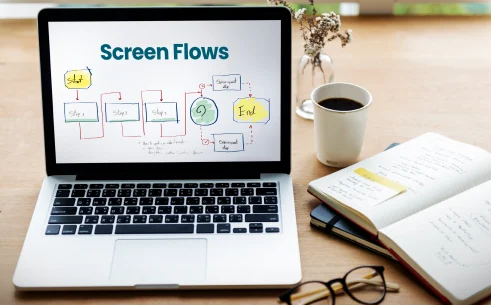Table of Contents
If you’re preparing for a Salesforce Admin interview, it’s essential to understand the platform beyond just clicking through the UI. Employers look for admins who not only know how Salesforce works, but also understand its limitations, automation tools, data security, layouts, and reporting capabilities.
This guide covers the top Salesforce Admin interview questions across key topics, with straightforward explanations to help you master the core concepts and stand out in your interview.
Limitations
1. What are the limitations of Master-Detail relationships in Salesforce?
In Salesforce, a custom object can be linked to at most two other objects using master-detail relationships. The detail record doesn’t have its own ownership or sharing settings—it follows whatever the master record has. Also, if you delete the master record, all its related detail records get deleted too. You can’t just move a detail record to another master unless a specific setting is turned on. Lastly, standard Salesforce objects can’t be used as the detail side in this kind of relationship.
2. What are the limitations of Lookup relationships in Salesforce?
Lookup relationships are more flexible than master-detail but come with their own limits. They don’t delete child records automatically if the parent is deleted, and they don’t support roll-up summary fields. Each object can have up to 40 lookup relationships. The parent and child keep separate control over who can see or edit the records, which is why lookup is better for loosely connected data.
3. What are the limitations of custom objects in Salesforce?
You can create up to 2,000 custom objects in a Salesforce org. Each object can have up to 500 custom fields. Custom object names must be unique across the system. Some features like activities, reporting, or tracking changes need to be turned on manually for each object. Also, if you want users to access them easily, you might need to create tabs for them.
4. What is the field history tracking limit in Salesforce?
Salesforce lets you track changes up to 20 fields on a single object. This history stays in the system for 18 months if you access it through the UI, and for 24 months through the API. If you need longer retention or want to track more fields, there’s a paid feature called Field Audit Trail. Note that you can’t track fields like formulas.
5. What is the difference between Setup Audit Trail and Field History Tracking?
Setup Audit Trail records changes made to the system’s settings, like configuration changes by admins. It’s useful for tracking who changed what in the setup menu and keeps a record for six months. Field History Tracking, on the other hand, shows changes made to individual records, like edits to a contact’s phone number. This happens on a per-object basis, while the audit trail looks at the entire system.
6. What are Governor Limits in the context of Salesforce automation?
Governor Limits are built-in controls that stop any user or process from using too many resources in Salesforce’s shared environment. For example, you can only run 100 SOQL queries or 150 DML operations in one transaction. You also have limits on flow elements and CPU time. If you go over these limits, your automation fails. These limits ensure the platform runs efficiently for everyone.
7. How many validation rules can be created per object in Salesforce?
Each object in Salesforce can have up to 500 active validation rules. If a rule is inactive, it doesn’t count against this limit. Be careful not to overuse them though—too many rules can slow things down when users try to save records.
8. What are the limits on roll-up summary fields in Salesforce?
You can create up to 25 roll-up summary fields on each object, and they only work with master-detail relationships. These fields can’t be used with certain field types like long text or multi-select picklists. Also, if you want to use them with flows, you’ll need a workaround tool like DLRS because they aren’t directly supported.
9. What are the limits on formula fields in Salesforce?
Formula fields can only use up to 5,000 characters after being compiled, even though the actual formula text might be longer. They can reference up to 10 related objects. However, you can’t use them to run database queries or updates. If you try to make a formula too complex, especially with lots of nested IF statements, it might not save at all.
10. What are the Salesforce record type limits per object?
Salesforce allows you to create up to 200 record types per object. Record types help you customize page layouts and picklists for different business needs. They’re often used to show different screens and fields depending on user roles or processes, but managing them at scale requires careful setup.
11. What are validation rules, and why are they used in Salesforce?
Validation rules in Salesforce are a set of rules that define the criteria that users are required to meet when they are creating or updating records to maintain data quality and consistency. Validation rules ensure that data in Salesforce complies with specific business needs and validation logic.
12. What is the difference between a Workflow Rule and a Process Builder in Salesforce?
Both the workflow rule and process builder are automation tools that allow businesses to define and automate various business processes and actions; however, they have different functions and capabilities.
Process Builder has more automation features and is more versatile. It lets you set up complicated processes with many criteria, steps, and decisions. With Process Builder, you can automate processes that create, update, or delete related records and trigger flows. It can do more than just design, update, and delete records. It can also launch flows and call custom Apex code, so it’s better for more complicated business processes with multiple steps and decision points.
Unlike Process Builder, Workflow rules are more basic and have fewer features. They’re mainly for automating simple stuff like sending emails, changing fields, and generating tasks based on specific criteria. Workflow rules can update fields, send emails, and create jobs. They’re all about ensuring users are updated or notified when certain conditions are met.
Read More:
50 Salesforce Interview Questions That Will Get You Hired in 2025
Salesforce Flows & Automation
1. What are Salesforce Flows and why are they important?
Salesforce Flows are automation tools that allow you to collect data, apply logic, and perform actions without writing code. They’re used to handle everything from updating records to sending emails and help simplify complex business processes.
2. What are the types of flows in Salesforce?
There are several flow types:
- Record-Triggered Flows run when records are created or updated
- Scheduled Flows run at set times
- Auto-Launched Flows are triggered by code or other flows
- Screen Flows involve user input
- Platform Event–Triggered Flows respond to events
- Orchestrations manage multi-step processes
3. What are the best practices for designing flows?
Use subflows to organize logic. Don’t hardcode values—use variables or custom labels. Add error handling, use entry conditions to reduce load, and always consider platform limits to avoid automation failure.
4. What is Flow Debugging?
Flow Debugging helps you test how your flow runs, either through a visual canvas or error logs. You can pause flows, view step-by-step execution, and test different scenarios without activating the flow.
5. How does “Run As Another User” work in flows?
This feature lets flows run using the permissions of a selected user, which is helpful for enforcing access controls or testing how flows behave for different roles.
6. What is Rollback Mode in flow debugging?
Rollback Mode allows you to test flows without saving any changes to real data. It’s useful for development or testing, especially when the flow performs updates or creates records.
7. What are the limit constraints for flows?
Each flow interview can process up to 2,000 elements. Flow execution limits vary by edition and are subject to governor limits like CPU time and SOQL queries. Loops should be kept under 200 items.
8. Can flows replace Process Builder and Workflow Rules?
Yes. Salesforce is phasing out Process Builder and Workflow Rules in favor of Flows. Flows are more powerful, flexible, and better suited for handling complex logic. They also perform better and can do more in a single automation. Salesforce provides tools to help you move existing automations to flows with minimal effort.
9. How can we trigger a flow from Apex?
You can start an auto-launched flow from Apex code by creating an instance of the flow and passing in any required variables. You use a map to send values into the flow and then call the start() method. This is useful when you need to mix custom code and declarative automation in the same process.
10. What is the order of execution between flows and other automation tools?
When a record is saved, Salesforce follows a specific order to run automations.
Step 1: It runs before-save flows.
Step 2: It checks validation rules.
Step 3: It runs after-save flows, assignment rules, and auto-response rules.
Step 4: Workflow rules and processes from Process Builder.
Step 5: It runs Apex triggers.
Step 6: Finally, anything that happens after the record is committed, like sending emails or running async flows.
Understanding this order helps avoid conflicts and duplicated actions.
11. What do you understand about workflows and triggers?
Workflows and Triggers are automation features in Salesforce but have different purposes and functionality. Workflows are rules and actions performed on a record when certain conditions are met. They are flowcharts that we create to execute a trigger-based action.
Whereas Triggers are used in our workflows to determine how the action will be triggered. Actions like insertions, updations, and deletions. It is an Apex code that is run to perform actions over values.
12. What is an approval process?
An approval process in Salesforce is a workflow automation tool that routes records for approval based on predefined criteria. It allows organizations to define rules and steps for approving records, such as opportunities, leads, or contracts. Designated approvers review the record during an approval process and can approve, reject, or reassign it as needed.
Approval processes can include multiple steps, parallel or sequential approvers, and custom notifications to keep stakeholders informed throughout the process.
Data Security in Salesforce
1. What are the different levels of data security in Salesforce?
Salesforce uses object-level, field-level, and record-level security to control data access. Profiles and permission sets control object access, field-level security hides or shows specific fields, and sharing settings manage who can see individual records.
2. What’s the difference between Profiles and Permission Sets?
Profiles are required and define the base level of access. Permission Sets are optional and provide extra access without changing the user’s profile. They allow for more flexible permission management.
3. What is a Permission Set Group?
A Permission Set Group bundles several permission sets into one. It simplifies access control and allows you to mute certain permissions within the group, which is useful in large organizations.
4. What are Organization-Wide Defaults (OWD)?
OWDs define the base level of access to records: Private, Public Read Only, Public Read/Write, or Controlled by Parent. These settings work with roles and sharing rules to open access as needed.
5. What’s the difference between Role Hierarchy and Sharing Rules?
Role Hierarchy gives users access to their subordinates’ records. Sharing Rules provide access across different roles or public groups, letting you fine-tune access beyond the hierarchy.
6. What types of Sharing Rules are available?
You can use owner-based rules to share records based on record owner, or criteria-based rules to share based on record values. Guest and territory-based rules are also available for specific use cases.
7. What is a Queue in Salesforce?
A queue is a group of users who can collectively own records like Leads or Cases. It keeps records secure until someone takes ownership and helps with workload distribution.
8. What are Public Groups, and how are they different from Roles?
Public Groups combine users, roles, and other groups. Unlike Roles, they aren’t tied to hierarchy. They’re used in sharing rules, folder access, and queue assignment.
9. What’s the difference between Manual Sharing and Apex Sharing?
Manual Sharing is done by users through the UI to share individual records. Apex Sharing is controlled by code, making it suitable for large-scale or automated sharing logic.
10. How can a user see why they have access to a record?
In Lightning, users can click “Why can I see this?” to view access reasons. Admins can use Sharing Settings and Audit Logs to understand how and why access was granted.
11. What is the difference between Profiles and Roles in Salesforce?
Profiles determine what a user can do within Salesforce, and only Object Level and Field level access can be created, like general permissions, tab-level permissions, and more.
Roles in Salesforce are mainly used to create record-level access, establishing a hierarchical structure allowing users to view and edit other users’ records. We can provide record-level access using roles, like company-wide defaults, role hierarchies, sharing rules, or manual sharing. Record-level access is affected by duties.
12. How are Public Groups and Queues Different?
Public Groups and Queues are both ways of organizing and managing records and tasks in Salesforce, but they serve different purposes:
Public Groups are users with shared access to records, files, and other resources in Salesforce. They are primarily used for sharing records, collaborating on projects, and simultaneously assigning tasks to multiple users. Administrators can manually create Public Groups and include individual users and other public groups.
Queues are virtual groups in Salesforce used to manage records and tasks that require a collaborative effort or follow a specific workflow. Unlike public groups, queues do not contain individual users but hold records awaiting action or resolution. Queues can be used for various purposes, such as managing support cases, leads, or service requests. Records in a queue can be assigned to individual users or picked up by members based on predefined criteria, such as workload or expertise.
Layout and UI in Salesforce
1. What is a Page Layout and why is it important?
Page Layouts control how fields, buttons, and related lists appear on a record. You can assign different layouts to different profiles to tailor the experience and help users focus on relevant data.
2. What are Record Types and how do they help the UI?
Record Types let you show different layouts, picklists, and processes based on the kind of record being created. They’re useful when one object supports multiple business use cases. For example, you might have one record type for B2B leads and another for B2C leads, each with different fields and workflows.
3. What is a Person Account and how does it differ from a Business Account?
A Person Account merges account and contact data into one record, used in B2C scenarios. Business Accounts represent companies and are linked to multiple contacts. Person Accounts need to be enabled separately.
4. How do you create a custom app in Lightning Experience?
In App Manager, click “New Lightning App,” set a name, logo, and navigation style, then add objects, tabs, and assign profiles. Custom apps help tailor the workspace for different teams.
5. What are Quick Actions?
Quick Actions are buttons that let users quickly create or update records, log calls, or run custom logic. They’re placed on record pages and global layouts to improve productivity.
6. What is Page Overriding?
Page Overriding replaces the standard page with a custom Visualforce page or Lightning Component. It’s used when you need a custom UI or more advanced business logic.
7. How do you add sections to a Page Layout?
In the layout editor, drag a “Section” onto the page, set columns and a name, then place fields into it. This helps organize information clearly for the user.
8. What are Dynamic Forms?
Dynamic Forms let you show or hide fields and sections based on data or user profile, without using record types or code. This provides a cleaner, more personalized layout.
9. How do Validation Rules improve the UI?
Validation Rules help users enter correct data by blocking invalid inputs. They display error messages that guide the user to fix mistakes, improving both data quality and user experience.
10. Can you create different UI for mobile and desktop?
Yes. You can create mobile-only layouts, use Compact Layouts, and display components based on device type. This ensures users have an optimized experience on any device.
Reports and Dashboards in Salesforce
1. What are the types of reports in Salesforce?
There are four main types:
- Tabular for simple lists
- Summary for grouped data
- Matrix for comparing rows and columns
- Joined for combining data from multiple report types
2. What are Dashboards? What are the different types of Dashboards?
Dashboards are an integral part of Salesforce’s data visualization platform. They offer a single view of critical business metrics and information in real-time, allowing you to track KPIs and progress and make informed data-driven decisions.
There are two types of Dashboards:
Static Dashboards: These are dashboards where the components and data are fixed at the time of creation, and they remain the same until manually updated by the dashboard creator. The same data is visible whenever a user accesses the dashboard until any change is made manually.
Dynamic Dashboards: Dynamic dashboards enable us to visualize a set of metrics within an organization. These dashboards are designed to provide security controls for Salesforce dashboards. The content on these dashboards is not fixed and refreshes automatically based on intervals and customer interactions. It allows the users to view the most current data available.
3. How is a Dashboard different from a report?
A dashboard displays report data visually using charts and metrics. Reports show raw data; dashboards give quick, visual summaries—ideal for tracking performance or KPIs.
4. What are Dashboard Components?
Each chart, graph, or table on a dashboard is a component, showing data from a report in a specific format. You choose the format based on what’s most useful to visualize.
5. What is a Dynamic Dashboard?
Dynamic Dashboards show data based on the logged-in user’s access. This lets you use one dashboard for many users without creating multiple versions.
6. What are Report Filters and Filter Logic?
Report filters limit the data shown by setting specific conditions—like showing only leads from the last 30 days or opportunities above a certain amount. Filter logic lets you combine multiple filters using AND, OR, and NOT to control how they work together. For example, you can show records that meet all conditions or just some, depending on how you structure the logic. This makes reports more flexible and targeted.
7. How can you schedule a report or dashboard in Salesforce?
You can schedule a report or dashboard by subscribing to it. When you subscribe, you choose how often you want it sent—daily, weekly, or monthly—and set any conditions that must be met. For dashboards, you can also schedule refresh times and have the results emailed to users. This helps keep teams updated automatically, without having to log in and run the reports manually.
8. What is a Bucket Field in Salesforce Reports?
A Bucket Field lets you group report data without needing a formula or creating new fields in the object. For example, you can group Opportunity Amounts into categories like “Small,” “Medium,” and “Large” without editing the actual records. This is great for quick categorization and analysis when you don’t want to change your data model.
9. What is a Custom Report Type in Salesforce?
Custom Report Types (CRTs) allow you to build reports that go beyond standard relationships between objects. You can decide which objects to include and which fields are available. You can also define optional object relationships to show or hide records based on whether related data exists. Custom Report Types are useful when standard report types don’t give you enough flexibility or when you need to report across custom objects.
10. Can you filter Dashboard Components individually?
By default, filters on a dashboard apply to all components. You can’t apply separate filters to each chart or table within the same dashboard. If you need different filters for each component, your best options are to create separate reports tailored for each component or build multiple dashboards. Joined Reports can also offer some flexibility in presenting diverse data views in one layout.
11. What are some best practices for building effective dashboards in Salesforce?
To make dashboards effective, focus on clarity and relevance. Including only the most important metrics—usually around 8 to 10 components per dashboard is enough. Use a mix of chart types to make the data easy to interpret. Dynamic dashboards help personalize the view for each user. Use color coding to highlight trends or issues, and make sure each component is connected to a well-filtered, up-to-date report. A clean, focused dashboard helps users quickly understand what needs their attention.

Conclusion
That’s it for our Salesforce Admin interview questions. Focus on giving clear, confident answers that show you understand the platform. Sharing real examples can make your responses stronger and more memorable. Your knowledge is key, but how you present yourself matters just as much. If you want to improve your skills, consider a Salesforce Admin training program. It can give you the hands-on experience and deeper understanding needed to succeed in the role.
Join our newsletter: Get daily update on Salesforce career insights & news!
Join Now!
















